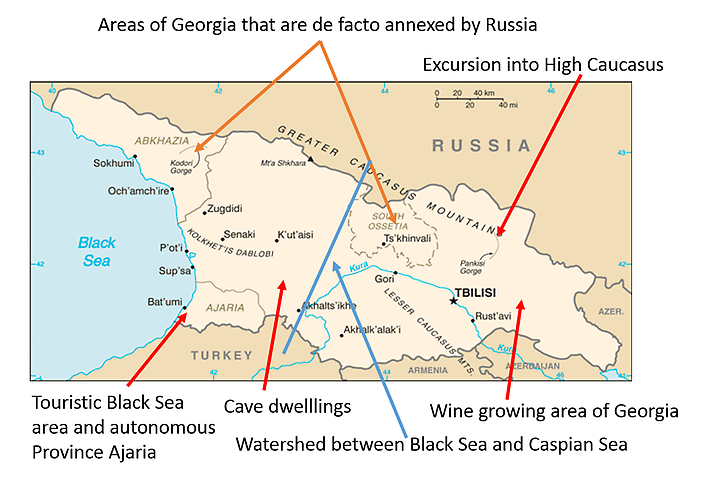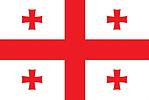Georgia (German: Georgien)#
Report of a trip June 2014 by Hermann Maurer. Corrections and comments are welcome! hmaurer@iicm.eduGeorgia has already played an important role in ancient times. Just consider all the stories about the mythical golden Fleece! Colchis, an area of the Caucasus now west of what is Georgia, was rich in gold. It is said that sheep skins (fleeces) where used to get the dust of gold out of the waters in the streams.
In archaeological excavations very beautiful and artistic pieces of gold have been discovered in the graves of archaic and classical times.
In the main excavation at Wani, 60 km from the Black Sea first artefacts were already found in 1876. But on a large-scale, excavations starting in 1960.It became apparent that an impressive civilisation must have already existed around the 8th century B.C. with its culmination between the 6th and 4 th century B.C. Impressive examples of goldsmithery were found, including intricate objects made of woven strands of gold.
If not earlier, than at least with the start of Greek colonization of the South coast of the Black Sea in the 8t century B.C., oral traditions start to mention aspects that were later put together in the saga surrounding the Argonauts. The region involved was clearly to the East of the Black Sea. Also, for the first time a region named Kolchida is mentioned in Greek literature.
Georgia was the second country that adopted Christianity as state religion in 330, following Armenia in 301. It is a bit ironic that two today quite small countries both have a version (but not identical) of orthodoxy as state religion, both have intricate alphabets that only look similar because of the rounded shapes of even printed characters.
The further political history of Georgia is very complex, so a very much shortened description has to suffice here. Georgia was overrun a number of times from the East, then was annexed by of Russia in 1801, and after a short period of independence after the revolution in Russia in 1917 it was occupied by the Soviet Union in 1921. It declared independence in 1991.
During Soviet times the identity of Georgia was weakened by the foundation of three autonomous regions: Abkhazia, South Osetio (both bordering Russia) and Ajaria (bordering Turkey). Abkhazia and South Osetio have become de facto parts of Russia after serious armed conflicts, but Ajaria is likely to remain integral part of Georgia as will be explained in the section on Batumi.
Industrialisation and tourism during Soviet times made Georgia highly dependent on Russia. So when independence was declared and all trade with Russia stopped Georgia was at the verge of economic breakdown . Some two million desperate people (30%) left the country. The ruinous state of affairs turned to the better after the “rose revolution” in 2003, installing a democratic government and economic reforms. Yet the population continues to drop, albeit by less than 0.4% the five years 2010- 2105 to around four million by 2105 (from almost 6 million in 1991).
However, agricultural development has grown by 500% in the last less than 20 years, i.e. a certain (healthy) return to a more agricultural economy is happening.
Thus, the political and economic situation has improved, even if this is not directly visible in the capital Tbilisi or in Batumi, where tourism is picking up again.
Georgien hat schon in der Antike eine große Rolle gespielt, man denke nur an den Mythos des Goldenen Vlies: Im goldreichen Kolchis, ein im Westen des heutigen Georgien gelegenen Gebietes am Kaukasus, wurden angeblich Schaffelle verwendet, um Goldstaub aus den Flüssen zu waschen. Ausgrabungen in Georgien brachten besonders kunstvoll getriebene Goldgegenstände aus den Gräbern der Archaischen und Klassischen Zeit hervor. Am Fundort Wani, 60 km vom Schwarzen Meer, kam schon seit 1876, in großem Umfang bei den Grabungen in den 1960er Jahren, eine hochstehende Kultur mit zahlreichen Zeugnissen der Goldschmiedekunst zu Tage – darunter auch feinste Gewebe aus Goldfäden. Der Höhepunkt dieser Kultur lag im 6. bis 4. Jahrhundert v. Chr. Spätestens bei Beginn der griechischen Kolonisation entlang der Südküste des Schwarzen Meeres im 8.-7. Jahrhundert v. Chr. gab es eine mündliche Überlieferung, welche den Kern der Argonautensage enthielt und sich auf die Region im Osten des Schwarzen Meeres bezogen haben muss. Im 8. Jahrhundert wird in der griechischen Literatur erstmals ein Land Kolchida erwähnt, dessen Blütezeit wohl in dieser Zeit lag.
Georgien wurde im Jahre 330 nach Armenien (301) das zweite Land der Welt mit christlicher Staatsreligion. Die Geschichte von Georgien ist so wechselhaft, dass sie hier nur kurz beschrieben zu werden kann: mehrmals überrannt von Völkern aus dem Osten, dann Teil Russlands, dann kurze Unabhängigkeit, aber 1921 von der Sowjetunion besetzt, und nach dem zweiten Weltkrieg nochmals, bis es 1991 seine Unabhängigkeit erklärte. Mehr im Beitrag über Georgien. Ein kurzer (90 Sekunden) netter Film über Georgien.
Schon zu Sowjetzeiten wurde Georgien durch die Gründung von drei autonomen Republiken Süd Osetien, Abkhazien (beide an Russland angrenzend) und Ajaria (an die Türkei grenzend) in seiner Gesamtheit geschwächt: die beiden ersterwähnten autonomen Republiken sind durch Intervention Russlands inzwischen de facto von Georgien unabhängig. Ajaria wird sich wohl auch wegen seines Sonderstatus hingegen kaum von Georgien trennen. Die Industrialisierung Georgiens beginnend mit Stalin und der Tourismus machte Georgien so abhängig von Russland, dass nach der Unabhängigkeitserklärung und Öffnung des Landes dieses am Rande des Ruins stand und über eine Million Bürger das Land verließen. Die Bevölkerung 2006 war um 4,5 Millionen. Die Agrarwirtschaft hat sich in den letzten 20 Jahren verfünffacht, d.h. es ist eine gewisse (wohl vernünftige) De-Industrialisierung zu vermerken. Die wirtschaftliche und politische Situation hat sich gebessert, bleibt aber weiter prekär, auch wenn das in der Hauptstadt Tiflis (Tbilisi) und der größten Stadt Ajarias, Batumi (siehe späterer Teil) nicht so evident ist.
- The capital Tbilisi (German: Tiflis)
- Mzcheta
- The high Caucasus North of the capital
- The cave cities in central Georgia
- Kutaissi, famous for Gelati
- Batumi on the Black Sea
- The botanical garden of Batumi
- Ubisa monastery
- Open air museum of old farmhouses near Tibilis
- The wine growing region of Georgia
Ein 9 Minuten längerer Film über Georgien

